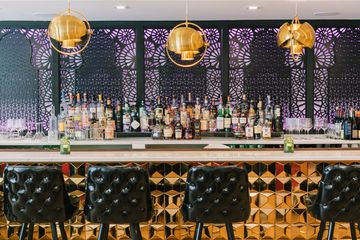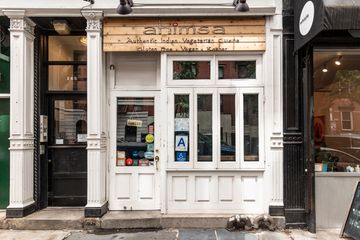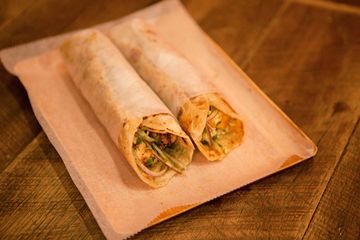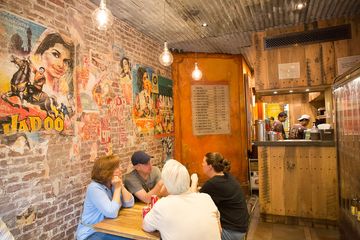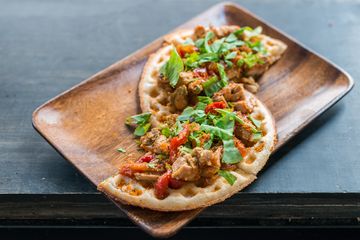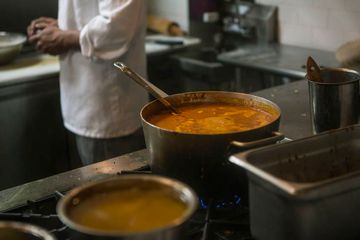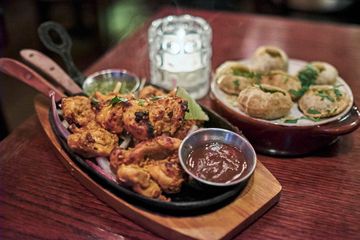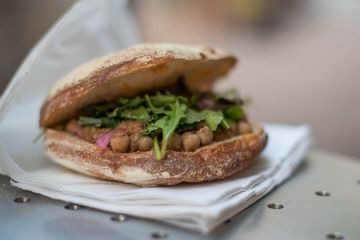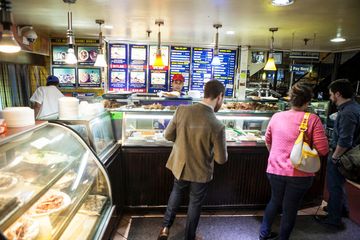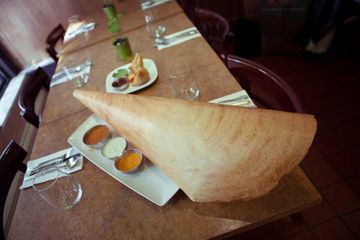"Monkeys are whimsical and playful and that fits with our theme, " Arun relayed to me on the evening that we sat down in his Indian restaurant and cocktail bar. Arun grew up "all over. " His dad was a diplomat who moved the family every few years from India to Washington to London. "I was constantly having new friends, a new home, a new school - a new life. " But, in hindsight, Arun said that it was an amazing way to be raised, and he appreciates what his parents did for him. "Hey, I have a friend and a couch in every city that I need to crash now. "Arun spent time working in other restaurants and bars over the years, but it was always his dream to have his own place. He just needed to figure out exactly what his concept would be. Initially, he thought he would open a cocktail bar, as there were none in the surrounding area at the time. "I recognized the density in population, and the variety of restaurants, but there was nowhere for people to go to have a nice drink and relax in this neighborhood, " he said. After admiring the bistro format derived from his uncle's successful restaurant, Bateau Ivre, which opened in 1995, Arun sat down with the man that he had always admired to discuss some of his ideas for starting a business. Enthusiastic about Arun's concept, his uncle took Arun to India where the two solidified their partnership. Now, periodically, they will travel back to their native country as well as to England to refresh their palate and come back to Manhattan with new recipes to try. There is a limited menu - not one's typical Indian choices - highlighting a little bit of everything from India’s North to its South, as well as the classic street food found in India. They are continuously revamping the menu and trading dishes with their fairly new downtown location, Royal Munkey. Many of the recipes that Executive Chef Derik Alfro uses are from Arun's mom, grandmother, and other members of the family. "This is home style cooking, " Arun told me as he placed a plate of white bread in front of me, cut into triangles with a mild cheddar cheese shredded over it and a bit of red onion, cilantro and green chili mixed in. "This is the kind of food we would eat at home, and at Drunken Munkey, we are trying to serve it in a similar style and setting. "While Arun tasted the chicken alongside the rest of us from Manhattan Sideways, he pointed to the accompanying sauce and told us that it was his grandmother's recipe - a play on the traditional tamarind made with apple butter, a blend of ground spices, and lemon that steeps for a few days before it is ready to be served. A number of other dishes were brought out, including a bowl of crispy fried okra and Paani Pori - tiny appetizers that we popped into our mouths and let explode with beautifully spiced liquid. Next, the team devoured a plate of perfectly cooked baby lamb chops while I tasted the cubes of cheese in the classic, but marvelous tomato-spiced sauce. Arun then commented on the mango dessert that Royal Munkey serves, explaining that it is inspired by Arun's memories of his mom serving his dad a fresh cut mango every evening on top of a bowl of vanilla ice cream - "simple, refreshing and delicious. "There are two photos that are especially sweet hanging on the wall - one of Arun's parents' wedding and the other of his grandparents. Arun's mom continues to come by at least once a week to sample the food and to give "valid pointers. " It is a combination of every one's skills that makes the menu a perfect blend of dishes. Even Arun's ninety-four year old grandmother comes by to check on things. Arun refers to her as the "entrepreneurial brain" in the family. Arun continued to discuss the interesting menu, describing it as "Anglo Indian. " He proceeded to give us a quick history lesson about the British and Indian relationship to food. As a child, Arun loved hearing the tale of how the Brits and the Indians melded their lives and their food. Vinegar was a common ingredient used in both countries, but the similarities stopped there. Everyone had a different take on which spices to grind and include in their dishes. As Arun tells it, the English did not use spice, and therefore their food was bland, but the Indians introduced them to an entirely new way to appreciate whatever they were preparing - even Shepherd's Pie. The name of the Royal Munkey's menu, "Mess Hall, " harkens to a time when the best fare could often be found in officers clubs and railways cars and Indian street food. Arun, however, thinks of the bar as the center piece to the restaurant and that the food is meant to complement the beautifully crafted cocktails. His cocktails are based on old British drinks and tied into India - little stories are mentioned throughout the drink menu in addition to historic references. "People who come in who are from India immediately appreciate the history that surrounds them and can relate to it, " Arun told me. It is not only the food, however, that draw them in: it is also the ambience. Although there are Bollywood flicks playing on the wall next to the bar and toy trains hanging in a different area, the wooden panels alongside the mirrored glass wall could easily translate into a French bistro, a look that appeals to Arun's uncle. Because there is a limited amount of seating, Arun decided that he would like to support another business a few doors down, while ensuring that he would not lose his own potential customers. Therefore, if people come by without a reservation and cannot be seated for a little while, the Royal Munkey will give them a voucher and send them to Reif's Tavern for a drink. "It works out well for everyone this way, " Arun revealed. "People questioned my choosing to be on 92nd Street but it is proving to be just fine. " The restaurant stays open until three or four in the morning - something unique to this part of town - and the kitchen remains open alongside the bar. Arun ended our conversation by mentioning that he really wanted to be on a side street: "Besides the reduction in rent, there is a charm in being tucked away. "
